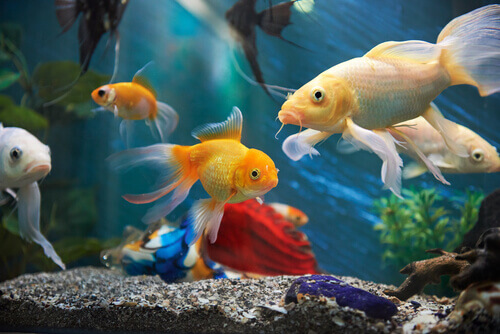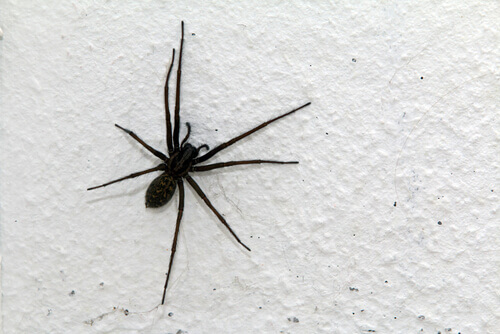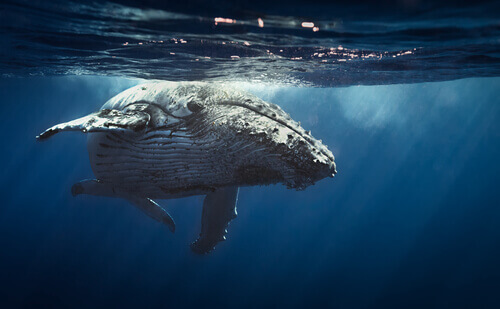Types of Respiration in Animals

Different types of respiration in animals are the result of species adapting to their environments. People tend to believe that all animals breathe the same way, or in a human way. However, in reality, there are very different ways of breathing.
In other words, respiration doesn’t occur the same way in a reptile, a mammal, a fish, or an amphibian. Each group has a different anatomy. Next, we’ll tell you about the different types of respiration in animals and the characteristics of each one.
The four types of respiration in animals
The basics of respiration are the gaseous exchange that takes place in a living organism. Through this exchange, the organism takes in oxygen (O2) and releases carbon dioxide (CO2).
Releasing carbon dioxide is essential since accumulating this gas is fatal. Also, obviously, without oxygen, no living being is able to survive.
1. Cutaneous respiration
This type of respiration occurs through the skin. It’s characteristic of echinoderms, annelids, and certain amphibians. The gas exchange – oxygen and carbon dioxide – happens when the dermis is humid. As a result, animals that breathe through their skin live in aquatic or very humid places.

It’s worth noting that these species have very fine, well-vascularized skin. This is necessary to breathe this way without problems. For example, some animals that breathe through their skin are cold-blooded animals, such as frogs, toads, jellyfish, anemones, and earthworms.
2. Respiration in animals: Branchial respiration
Gills are respiratory organs that aquatic animals have, with the exception of those that breathe through their skin. Oxygen is extracted from the water through the gills and carbon dioxide is released. This process allows O2 to pass into the blood, tissues, and cells.

Unlike lungs or tracheas, gills are external. In fact, you can see them behind a fish’s head. In other cases, they are appendages of different sizes in mollusks, newts, salamanders, and annelids.
Before reaching adulthood, insects and amphibians have gills. Later, they breathe using a different method.
3. Tracheal respiration
Animals that use this type of respiration have lungs that are called “book lungs.” For example, some animals that use this type of respiration are insects, arachnids, myriapods, such as centipedes and onychophorans. They have tube-like structures that allow oxygen to connect cells.

This system doesn’t use the circulatory system to move oxygen. In fact, these animals have very slow-moving blood, which doesn’t have the capacity to transport oxygen. Instead, there are tubes with a blowhole open to the outside that allows air to enter.
4. Respiration in animals: Pulmonary respiration
However, of all the types of respiration in animals, the lung is the one we’re most familiar with because it’s used by humans and other mammals.
Lungs are internal organs that can actually develop in two ways. For example, they can be secular (in the form of a sac) or tubular, which fills with air depending on the situation.
Adaptations to pulmonary respiration
Some animals have different forms of lungs. For example, reptiles have lungs with folds and a large surface area. On the other hand, snakes have a single lung because their bodies are so narrow. In addition, aquatic turtles have a modified circulatory system that allows them to carry out their vital functions without needing to come up to the surface for a long time.

Alternatively, mammals have very well-developed lungs. These lungs also have branched tubes called alveolar sacs. This is where gas exchange occurs.
However, animals of this species that live in the water, such as whales and dolphins, have a greater capacity for oxygenating their blood. As a result, they don’t have to introduce oxygen into the body as often as land animals.
Finally, birds have lungs adapted for flight. When they breathe, their lungs fill with air that passes into air sacs. This way, they don’t have to breathe while flying. The sacs act like an oxygen tank that they can empty according to their needs.
Once you realize that there are various types of respiration in animals, you see how complex and harmonious the animal kingdom is. All the different adaptations for respiration make this very clear, and they never cease to amaze us.
Different types of respiration in animals are the result of species adapting to their environments. People tend to believe that all animals breathe the same way, or in a human way. However, in reality, there are very different ways of breathing.
In other words, respiration doesn’t occur the same way in a reptile, a mammal, a fish, or an amphibian. Each group has a different anatomy. Next, we’ll tell you about the different types of respiration in animals and the characteristics of each one.
The four types of respiration in animals
The basics of respiration are the gaseous exchange that takes place in a living organism. Through this exchange, the organism takes in oxygen (O2) and releases carbon dioxide (CO2).
Releasing carbon dioxide is essential since accumulating this gas is fatal. Also, obviously, without oxygen, no living being is able to survive.
1. Cutaneous respiration
This type of respiration occurs through the skin. It’s characteristic of echinoderms, annelids, and certain amphibians. The gas exchange – oxygen and carbon dioxide – happens when the dermis is humid. As a result, animals that breathe through their skin live in aquatic or very humid places.

It’s worth noting that these species have very fine, well-vascularized skin. This is necessary to breathe this way without problems. For example, some animals that breathe through their skin are cold-blooded animals, such as frogs, toads, jellyfish, anemones, and earthworms.
2. Respiration in animals: Branchial respiration
Gills are respiratory organs that aquatic animals have, with the exception of those that breathe through their skin. Oxygen is extracted from the water through the gills and carbon dioxide is released. This process allows O2 to pass into the blood, tissues, and cells.

Unlike lungs or tracheas, gills are external. In fact, you can see them behind a fish’s head. In other cases, they are appendages of different sizes in mollusks, newts, salamanders, and annelids.
Before reaching adulthood, insects and amphibians have gills. Later, they breathe using a different method.
3. Tracheal respiration
Animals that use this type of respiration have lungs that are called “book lungs.” For example, some animals that use this type of respiration are insects, arachnids, myriapods, such as centipedes and onychophorans. They have tube-like structures that allow oxygen to connect cells.

This system doesn’t use the circulatory system to move oxygen. In fact, these animals have very slow-moving blood, which doesn’t have the capacity to transport oxygen. Instead, there are tubes with a blowhole open to the outside that allows air to enter.
4. Respiration in animals: Pulmonary respiration
However, of all the types of respiration in animals, the lung is the one we’re most familiar with because it’s used by humans and other mammals.
Lungs are internal organs that can actually develop in two ways. For example, they can be secular (in the form of a sac) or tubular, which fills with air depending on the situation.
Adaptations to pulmonary respiration
Some animals have different forms of lungs. For example, reptiles have lungs with folds and a large surface area. On the other hand, snakes have a single lung because their bodies are so narrow. In addition, aquatic turtles have a modified circulatory system that allows them to carry out their vital functions without needing to come up to the surface for a long time.

Alternatively, mammals have very well-developed lungs. These lungs also have branched tubes called alveolar sacs. This is where gas exchange occurs.
However, animals of this species that live in the water, such as whales and dolphins, have a greater capacity for oxygenating their blood. As a result, they don’t have to introduce oxygen into the body as often as land animals.
Finally, birds have lungs adapted for flight. When they breathe, their lungs fill with air that passes into air sacs. This way, they don’t have to breathe while flying. The sacs act like an oxygen tank that they can empty according to their needs.
Once you realize that there are various types of respiration in animals, you see how complex and harmonious the animal kingdom is. All the different adaptations for respiration make this very clear, and they never cease to amaze us.
This text is provided for informational purposes only and does not replace consultation with a professional. If in doubt, consult your specialist.








